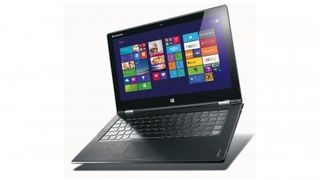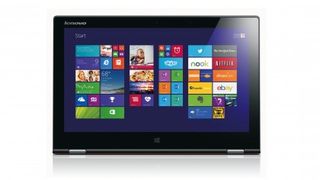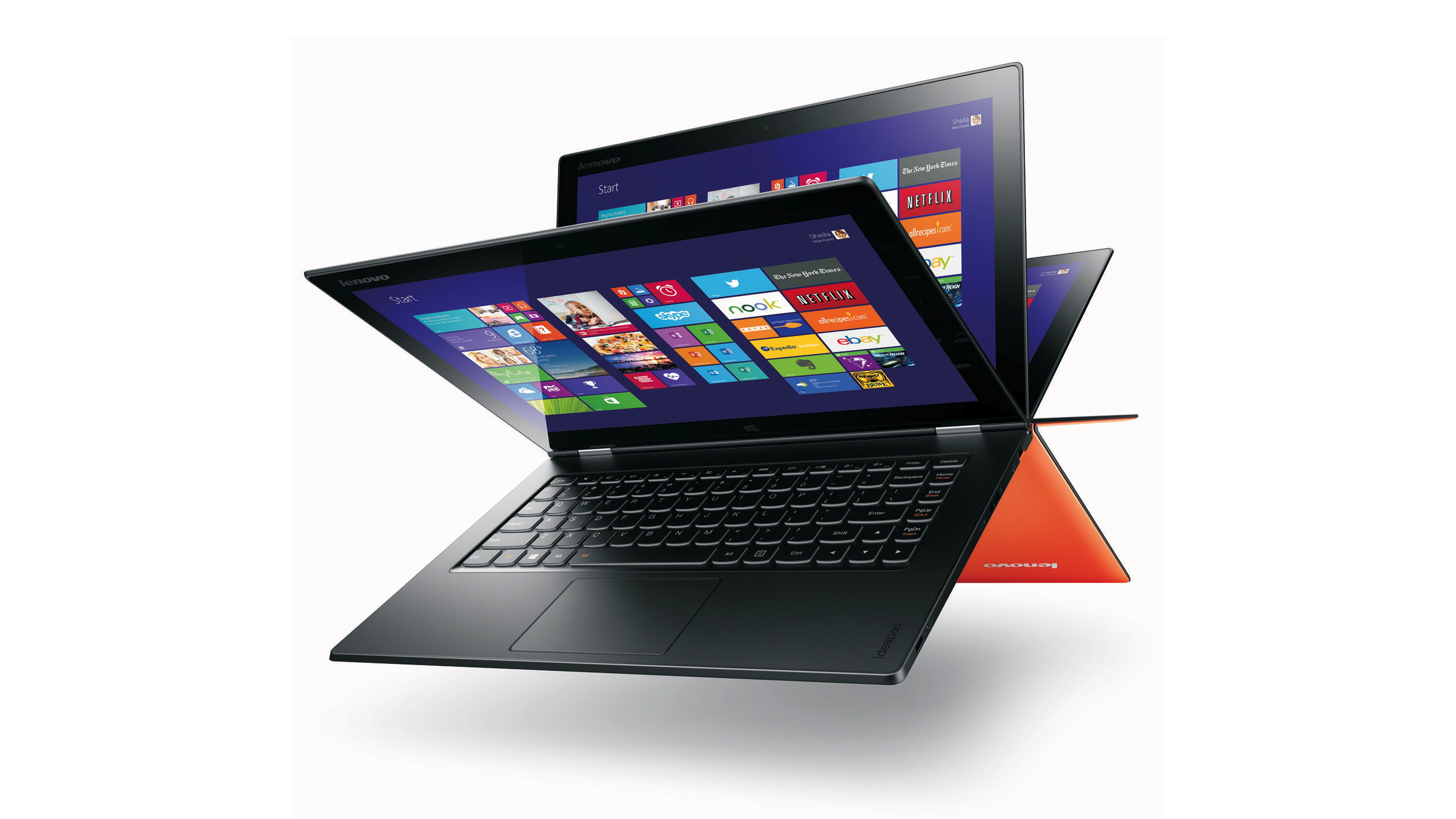Why you can trust TechRadar
It didn't blow us away, but the Lenovo Yoga 2 Pro performed quite capably in most of our tests. The tale, as they say, lies in the tape:
Benchmarks
- Cinebench - 9,125 (4,016 with 1x CPU)
- 3DMark - Ice Storm: 23,032 // Cloud Gate: 3,397 // Fire Storm: 545
- PC Mark – Home: 2,471 // Work: 3,309
- PC Mark Battery life - 190 minutes
What do the numbers tell us? First, that this is a reasonably configured device, capable of holding its own against other systems in the $1,000 or more ultrabook category. For this category, that's fairly common, and on par with other Haswell-based devices.
Truthfully, unless you play games, an SSD and Windows 8 are a great equalizer for price and performance in today's PC market, so it is no surprise that in real life we were satisfied with the Yoga 2's overall performance. The only thing you don't want with a Windows 8 ultrabook is an experience that is demonstrably slow, and that is definitely not the case here.

Boot times and all app launches are pretty much instantaneous thanks to the SSD. And while the integrated HD graphics aren't going to allow you to play Call of Duty Ghosts at any level of respectability, you can play most of the mid-tier Steam games—including new releases like The Wolf Among Us—at moderate settings.
As we noted at the top, there aren't very many ultrabooks with QHD+ displays. The Samsung ATIV Book 9 Plus is one such system, and it put up superior numbers across the board by 20% to 30%.
In the Yoga 2's defense, it does cost $400 less than the ATIV Book 9 Plus, and $500 less than Apple's newest, and quite awesome MacBook Pro.
Battery performance is a concern
The biggest weakness of the Yoga 2 Pro is its mediocre battery life. In PC Mark's built-in battery benchmark, we realized just over three hours of performance. That's actually not a bad result for a conventional laptop's synthetic test. But for a Haswell-equipped ultrabook? We expected, or at least hoped for more.
When you consider the 5.8 million pixels the system is pushing around, the middling battery life becomes a bit more understandable. In real life, what do these synthetic results mean? In real-work mode, you'll likely get just around five hours of battery life—if you keep the screen fairly dim. And in a more work-and-sleep mode, you'll get maybe six hours, depending on your battery settings. While writing this very review, we watched with dismay as the Yoga 2 Pro's battery drained to zero in about five and a half hours at full screen brightness.
Mouse and keyboard
The Yoga's keyboard hasn't changed since last year's model except that now the keyboard is backlit. The first Yoga sorely lacked this feature, which always comes in handy when working on a plane or late into the night. As far as key presses go it's fine, and offers decent response.
The trackpad has something of a learning curve. Out of the box, it had what felt like a slightly gritty, film over the pad itself, and the end result was that we struggled to throw the mouse around the screen. After about 10 days, we broke through whatever barrier was slowing us down, and it began to feel like we expect a touchpad to feel like: smooth, sleek, and responsive.
The display has it—mostly
Without a doubt, the Yoga 2 Pro's 13-inch screen is a remarkable feat of engineering. At 3200 x 1800 pixels, it out Retina Displays the MacBook Pro series. We know this much: QHD+ is a whole lot of pixels; it literally doubles the 1600 x 900 screen density of last year's Yogas like Lenovo IdeaPad Yoga.
Resolution is only part of the win here. Lenovo's use of a high-quality IPS panel also makes for a very crisp, viewable screen. The Yoga 2 is bright (350 nits) and offers excellent viewing angles. For a portable like this that will often be used in kitchens and living rooms, both of these attributes are important. At just $1,000 USD, it's a sure sign that in 2014 we'll be entering a laptop display war. By January 2015, we bet that more than half of all laptops in the $1,000+ range have hyper-HD screens.

Unfortunately, not all is perfect with the Yoga 2 Pro's screen. Last November, in our Lenovo IdeaPad Yoga review, we felt that it because it was such a forward thinking laptop, it actually exposed some of the flaws of Windows 8. Unfortunately, the same can be said here.
Time after time, we found that Windows 8 struggled with the super high resolution, which created some odd inconsistencies and unpredictable behaviors in day-to-day operations. Most of these frustrations occurred in desktop mode, but some oddities did crop up in Metro as well.
The short version of our difficulties boiled down to a conflict between such a high resolution display on such a relatively small screen. As an example, in Outlook, the main inbox/calendar window used an oversized cursor, but when we switched to the composition window, the cursor would shrink in size. Similarly in Chrome, the browser tabs suddenly became microscopic in size, even though there was plenty of real estate to display web site names in each one. (This occurred in both desktop and Metro modes.)
Over and over again, we experienced these frustrations, until we finally figured out a solution that addressed most of these issues. In Windows 8, navigate to Display > Screen Resolution, and then click "Make text and other items larger or smaller". From here, you can simply set the "Change the size of all items" field to scale the resolution in an appropriate manner. Large (150%) felt like the best fit—it did result in some fairly small fonts, but it also resulted in an abnormally large amount of real estate.

For what it's worth, TechRadar experienced the same display frustrations with Windows 8 on theSamsung ATIV Book 9 Plus. It's probably no surprise that we experienced no such frustrations with Apple's new MacBooks.
We know this much: Microsoft needs to address this kind of inconsistency with hyper-HD resolutions immediately. Running a 3200 x 1800 display in 1080p mode may be okay with most people—it does look quite nice—but it's squandering so much potential for the power user.
Interesting bundled software and camera
Lenovo bundles some interesting first-party utilities with the Yoga 2 Pro. Power users probably won't use them, but we can imagine less nerdy owners experimenting with some or all of these built-in apps. Here is a short breakdown of each:
- Smart Voice: This utility allows you to perform some basic, Kinect-like voice controls with your laptop.
- Phone companion: If you have an Android phone, you can pair it with your Yoga 2 Pro, and sync contacts, photos, and more. You can also send and receive text messages and even make phone calls using the laptop's mic and speakers. It's actually pretty great. In the world of iOS and MacOS, this is rapidly becoming a given. Microsoft should be embracing this kind of functionality with Android. Sadly, it is not.
- Camera Man: Allows you to take pictures of yourself using the Lenovo's 720p webcam, and enhance those pictures with a variety of special effects.
- Chef: This app, which contains thousands of free recipes and allows you to navigate and interact with the recipes using voice and hands-free gesture controls, is one of the most useful pieces of software we've seen bundled into a laptop. Very cool.
- Photo Touch: This add-on allows you to enhance photographs with a touch-optimized user interface. It's actually surprisingly useful if you don't already have a preferred app for basic photo editing.
- Yoga Picks: This software detects what mode you're operating in—laptop, tent, stand, or tablet—and pops up a message in the top right-hand corner of the device that allows you to click in order to get some mode-specific app recommendations. Lame for the power user, but we bet it's the kind of feature that will make casual users happy.
How to watch CMA Awards 2024 online – stream the 58th Annual Country Music Association Awards from anywhere

ChatGPT’s Advanced Voice Mode lands in your desktop browser – and it’s a big step towards its rumored Operator agent

These deals are just your type: save big in Logitech's massive Black Friday keyboard sale
